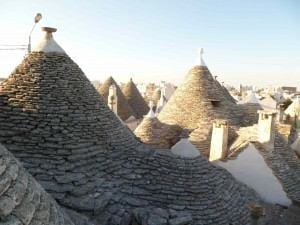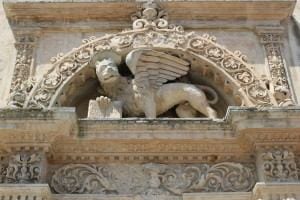ALBEROBELLO, LOCOROTONDO AND MARTINA FRANCA
 Farther inland is countryside, Itria Valley, home to Alberobello, Locorotondo and Martina Franca. Visit Alberobello, one of three UNESCO World Heritage Sites in Puglia. Suggestive of fairytale castles, Alberobello’s iconic whitewashed “Trulli” cottages feature cone-shaped roofs built from local Chianche stone. Roughly 1,500 remain, many which permit overnight guests. Due to its unique structure, these prehistoric cottages are said to always be a comfortable 65 degrees, rain or shine. Lunch at Casa Nova, where the owner serves an unforgettable lemon sorbet-like digestif, “Granita di limone” and sweets “fichi secchi ripieni” and “mandorle,” stuffed figs with almonds.
Farther inland is countryside, Itria Valley, home to Alberobello, Locorotondo and Martina Franca. Visit Alberobello, one of three UNESCO World Heritage Sites in Puglia. Suggestive of fairytale castles, Alberobello’s iconic whitewashed “Trulli” cottages feature cone-shaped roofs built from local Chianche stone. Roughly 1,500 remain, many which permit overnight guests. Due to its unique structure, these prehistoric cottages are said to always be a comfortable 65 degrees, rain or shine. Lunch at Casa Nova, where the owner serves an unforgettable lemon sorbet-like digestif, “Granita di limone” and sweets “fichi secchi ripieni” and “mandorle,” stuffed figs with almonds.
En route to Martina Franca is Locorotondo. Wander the town’s historic center, replete with narrow, hidden alleys and three-storied, gable-roofed houses. From Locorotondo’s hilltop, get a bird’s-eye view of Itria Valley, scattered with Trulli and some of Puglia’s 50 million olive trees.
In Martina Franca, a centerpiece for Puglian baroque architecture, don’t miss the stately Ducal Palace, built in 1669 on the site of an ancient castle constructed in 1338. To view the palace, walk through St. Anthony’s Arch, one of four remaining gates that once served as entrances to Martina Franca’s now-crumbled city walls. Study the baroque details in wrought iron balconies, loggias, lavish cherub-covered exteriors, and apotropaic masks, ornaments carved into the facade of buildings to ward off evil spirits. Sightseeing in Martina Franca is akin to admiring a painting—you’ll stare at its composition up close and afar, for hours.
LECCE
 Farther south is Lecce, a 14th-century town affectionately called the “Florence of the south” for its baroque architecture carved centuries ago from a soft limestone found only in Lecce. “Walk with your head up” as the saying goes because you won’t want to miss anything. Start at Lecce Cathedral, situated in Duomo Piazza, a square formerly used for military drills and as a haven where locals gathered during invasions. Marvel at Basilica di Santa Croce, the town’s most inspiring baroque example for its heavily decorated exterior of animals, saints, figures and cascading flowers—amazingly, it took three generations to build the church. Stroll Saint Oronzo square, where you’ll find an overlooking Saint Oronzo column topped with the statue of Lecce’s patron. Transported to Lecce after lightning struck it elsewhere, the column is one of two that represents the end of the Appian Way, an ancient road connecting Puglia and Rome. Lastly, visit Lecce’s 2nd-century Roman amphitheater, where gladiators once fought for 25,000 spectators. The amphitheater, used today for local concerts, was only partially excavated in 1905 due to it being buried under other historical structures in the town’s square.
Farther south is Lecce, a 14th-century town affectionately called the “Florence of the south” for its baroque architecture carved centuries ago from a soft limestone found only in Lecce. “Walk with your head up” as the saying goes because you won’t want to miss anything. Start at Lecce Cathedral, situated in Duomo Piazza, a square formerly used for military drills and as a haven where locals gathered during invasions. Marvel at Basilica di Santa Croce, the town’s most inspiring baroque example for its heavily decorated exterior of animals, saints, figures and cascading flowers—amazingly, it took three generations to build the church. Stroll Saint Oronzo square, where you’ll find an overlooking Saint Oronzo column topped with the statue of Lecce’s patron. Transported to Lecce after lightning struck it elsewhere, the column is one of two that represents the end of the Appian Way, an ancient road connecting Puglia and Rome. Lastly, visit Lecce’s 2nd-century Roman amphitheater, where gladiators once fought for 25,000 spectators. The amphitheater, used today for local concerts, was only partially excavated in 1905 due to it being buried under other historical structures in the town’s square.












